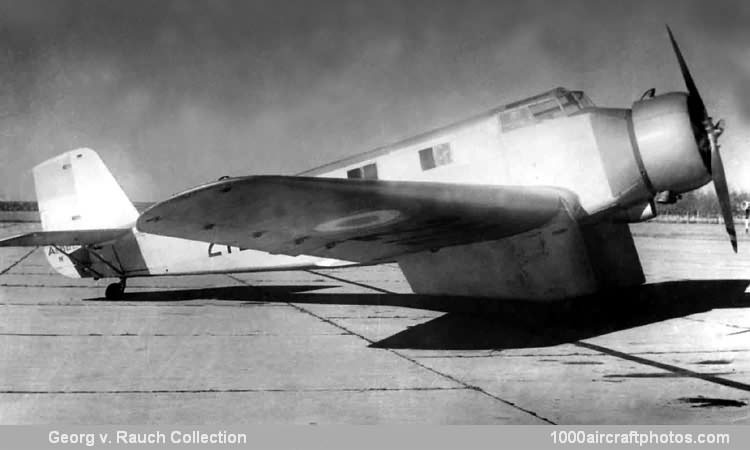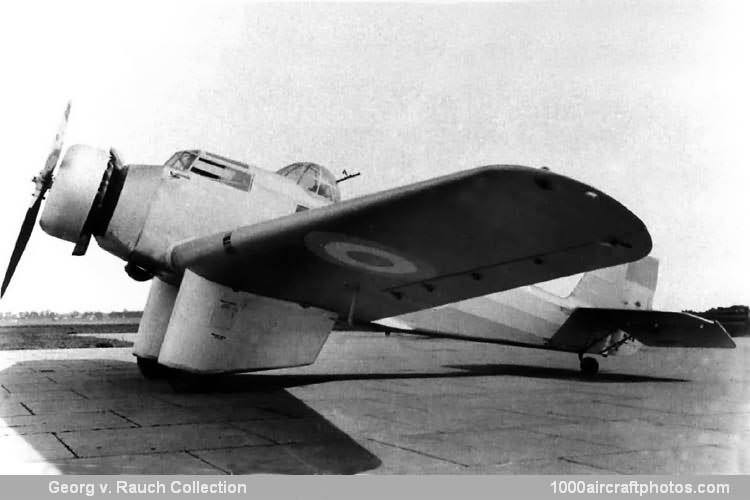Georg v. Rauch extracted the following Aé.M.B.1 and Aé.M.B.2 data from the book: Fábrica Militar de Aviones (FMA) 1927-1955 by Dr. Georg v. Rauch & Dr. Hernán Longoni. It was edited by Johan Visschedijk.
Although the Aé.M.B.1 (Aerotécnica, Militar, Bombardeo) was the first light bomber aircraft developed at the FMA, from the onset it designed to fulfill two separate roles: Bomber and transport. The basic Aé.M.B.1 design was that of cantilever, low-wing monoplane, with fixed landing gear. Pilot and co-pilot sat side-by-side in an open cockpit. The new design employed the typical FMA construction, steel molybdenum, Warren-trussed fuselage fabric with duralumin skin for the cockpit and fighting compartment, and fabric covering aft.
Powered by a Wright Cyclone SGR-1820F-3 rated at 715 hp at 6,890 ft (2,100 m), driving a variable speed three-bladed Hamilton Standard propeller 11 ft 9.7 in (3,60 m) in diameter, the prototype Aé.M.B.1 first took to the skies on June 9, 1935. Fixed armament consisted of a pair of Madsen Mod. 1933 0.3 in (7.65 mm) machine guns in a swiveling mount. Although the prototype displayed pleasant handling characteristics, it was modified to enhance crew comfort and performance.
The improved model featured a cockpit enclosure, a larger trapezoidal-shaped rudder, 353 lb (160 kg) of ballast on the rear portion of the cabin, trouser fairings for the main landing gear members which not only improved overall performance but conferred it a passing resemblance to the Northrop Delta 1.b transport.
In fact, some FMA posters and magazine advertisements displayed an idealized version of the new design which bore an even more striking similarity to the more famous Northrop design, which no doubt influenced the FMA design team.
The Aé.M.B.2, however, was an entirely original design whose overall dimensions and fuselage section resembled those of the Junkers K 43, which had equipped Argentine bombing units. The Aé.M.B.1 enjoyed a high degree of popularity among aircrews, which promptly earned it an endearing nickname: "Bombi".
The first production batch of eight aircraft was officially delivered to the Army on April 12, 1936, and the remaining six on August 12 of the same year. Thus, with the prototype a total of 15 machines were completed, and issued serial numbers 201/215. The Aé.M.B.1s were distributed to Reg. Aér. No. 1, 2 and 3, although Reg. Aér. No. 1 was allotted the proverbial "lion's share". Among the aircraft assigned to this unit were s/n 203, 204, 205, 207, 209, 210, 212 and 215. Aé.M.B.1 s/n 202, 211 and 214 were assigned to Reg. Aér. No. 2 at Paraná, while s/n 201, 206, 209 and 213 were with Reg. Aér. No. 3 at Los Tamarindos
We would like to point out that the available operational aircraft were often rotated among combat units, and that unit assignments mentioned here apply to the 1936-1938 period solely. The "Bombi" handled quite well and the few accidents recorded were not imputable to any inherent design flaw.
Defensive armament consisted of two Madsen Model 1933 7,65 mm. machine guns in a dorsal turret, a third Madsen 7,65 mm. firing through the propeller disk and a Madsen Model 1933 11,35 mm machine gun in a ventral position. An internal load of 400 kg was carried. Other equipment included a Nistri horizontal camera, a Telefunken radio set and Sperry-Rand blind flying instruments. Access to the cabin was through a door on the port side of the fuselage.
The crew consisted of a pilot, a co-pilot who doubled a radio operator and an observer/bomber. By removing the armament, bomb racks and other military equipment, the Aé.M.B.2 could be converted into a six-passenger transport in less than twenty minutes. It is worth noting that prior to the Noble inquiry, Aeroposta Argentina had signed a letter of intent with the FMA for a transport aircraft under development at the Córdoba plant. In the event, the airline opted for the Late 28 high-wing monoplane.
With the introduction of newer and faster types such as the Northrop 8A2 and the Glenn Martin 139 WAA, the Aé.M.B.1 type was progressively relegated to observation, transport and training tasks. On 5 February 1938, the aircraft was re-designated Aé.M.B.2. By 1943, the nine surviving machines were with Grupo de Observación No. 2 at Paraná. Aside from their normal duties, these aircraft were used as crop dusters on behalf of the Ministry of Agriculture and Livestock, alongside elderly Junkers K 43s until finally stricken off the inventory in November 1945.
|
Type: |
Single-engined, low-wing bomber monoplane |

